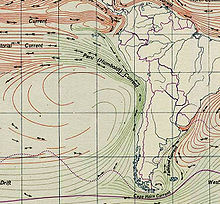Humboldt Current
The Humboldt Current, is also known as the Peru Current and is a cold, low-salt, near-surface ocean current on the west coast of South America, named after the German naturalist Alexander von Humboldt, who published his measurements of the cold ocean current in his book "Kosmos" in 1845. The Humboldt Current originates in Antarctica and flows north along the west coast of South America from Chile and Peru. South of the equator at about the latitude of northern Peru or Ecuador, the current leaves the coast and turns west toward the central Pacific Ocean. Along the way, the water slowly warms and mixes, then continues on its way as a warm South Equatorial Current.
The Humboldt Current is over 6500 km long from about 45 degrees south latitude to about 4 degrees south latitude and has a width of up to 900 kilometres. The surface temperature (Sea Surface Temperature; SST) can drop as low as 15 degrees Celsius, making it significantly colder (about 7 to 8 °C) than other sea areas of the same latitude. The water masses of the Humboldt Current displace other subtropical temperate water masses from the coast, thus influencing the coastal climate of Chile and Peru. The northward flow, together with the prevailing winds and associated Ekman transport, results in an upwelling region north of 30 degrees latitude south. The upwelling of nutrient-rich deep water has a direct influence on biological production. This ocean current is one of the most productive areas in the world, producing the most fish per unit area worldwide. Approximately 18 to 20 percent of the world's marine fish are caught here. Most of the fish species caught are pelagic fish: sardines, anchovies and mackerel. This high production makes commercial fishing possible and is also responsible for a large population of marine mammals (eared seals and whales) and birds
The cold waters of the Humboldt Current cool the air flowing over it before it hits the coast of South America in Chile, Peru and Ecuador. The cooled air reduces the likelihood of precipitation, even though clouds and fog form regularly along the coast. Because of this effect, the Humboldt Current is responsible for the dryness of the Atacama Desert in northern Chile and the coastal areas of Peru and southern Ecuador.
With the periodic occurrence of the El Niño phenomenon, the cold Humboldt Current weakens with major socio-economic and climatic impacts.

Humboldt Current
See also
- Global conveyor belt
- Trash Strudel
Questions and Answers
Q: What is the Humboldt Current?
A: The Humboldt Current is a cold, low-salinity ocean current that flows north along the west coast of South America from the southern tip of Chile to northern Peru. It is also known as the 'Peru Current' and it extends 1,000 kilometers offshore.
Q: Who was it named after?
A: The Humboldt Current was named after Prussian naturalist Alexander von Humboldt.
Q: What makes it an important marine ecosystem?
A: The Humboldt Current brings nutrients up into the surface waters of the ocean, which supports an extraordinary abundance of marine life. This high productivity supports other important fishery resources as well as marine mammals (eared seals and cetaceans) and seabirds.
Q: When does upwelling occur off Peru?
A: Upwelling occurs off Peru year-round but off Chile only during the spring and summer due to displacement of subtropical center of high pressure during summer months.
Q: How much fish catch comes from this current?
A: About 18-20% of the world’s fish catch comes from the Humboldt Current.
Q: What species are found in this current?
A: Species found in this current are mostly pelagic such as sardines, anchovies and jack mackerel.
Q: What drives its extraordinary productivity?
A: The cold, nutrient-rich water upwelling to the surface drives its extraordinary productivity.
Search within the encyclopedia